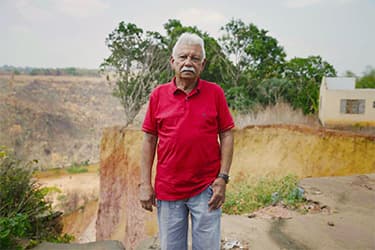This was once a bustling street in Buriticupu, a city in north-east Brazil.
Now it is a vast chasm 80m deep – a 20-storey building could fit inside it.
Canyons like this are known locally as “voçoroca” or “torn land” in the indigenous Tupi-Guarani language.
The phenomenon is a result of gully erosion, one of the most aggressive forms of soil degradation caused by rain and waste water.
And it is advancing at a worrying speed, destroying thousands of homes in Latin America and Africa.
Former police officer José Ribamar Silveira was nearly killed when he fell into this gully.
He got lost as he was driving home from a party one night in May 2023.
As he turned the car around, the 79-year-old reversed and accelerated backwards. It was dark, there were no warning signs or barriers around the voçoroca, and before he knew it, the car – with him inside – plunged into the vast hole.
“When the car slid, even though it was falling quickly, I thought of my youngest son,” he tells the BBC.
Baby Gael had turned four months old the day before. “I asked God to protect me so that I could raise my little son,” says Lt Silveira.
He was knocked unconscious and woke up at the bottom of the ravine three hours later. After a complicated rescue operation and months of convalescence, he can now walk without crutches.

His experience is a vivid example of the risks facing Buriticupu’s 70,000 residents.
As more gullies appear, there are fears that the city in Maranhão state, on the edge of the Amazon rainforest, could be split in two. At 350m above sea level, Buriticupu has about 30 gullies, with the largest two separated by less than 1km.
“If the authorities don’t contain this, they will meet and form a river,” says Edilea Dutra Pereira, a geologist and professor at the Federal University of Maranhão.
Gullies have been part of the Earth’s geological history for millions of years.
…click on the above link to read the rest of the article…